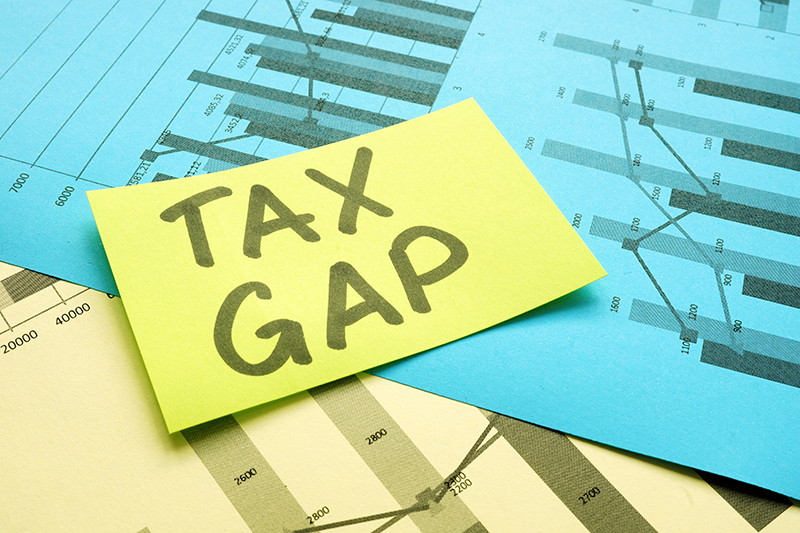TaxAudit reviews the Federal Tax Gap
September, 02 2020 by Carolyn Richardson, EA, MBA
In this day and age of talk about the massive federal budget deficits and increased government spending, particularly with the large economic stimulus payments required to boost the economy during the Covid-19 crisis, you may have heard the term “tax gap.” The tax gap is sometimes discussed when politicians talk about how to raise revenue to pay for all the expenses incurred by the government, such as in the CARES Act and proposed additional stimulus bills pending in Congress. You might have wondered to yourself “what is the tax gap?” Simply put, the tax gap is the difference between what the government actually collects in taxes versus what they should have collected in taxes to cover the real tax liability. Determining the amount of the actual tax gap is not a very precise science, but more along the lines of a crystal ball reading by your neighborhood psychic. This is because estimating something that hasn’t happened but should have, i.e., taxes that should have been paid, is inherently more difficult than estimating something based on actual hard facts, such as gross domestic product or Social Security taxes paid. For fans of alternate history, it’s rather like asking what the world would be like if the Allies had lost World War II. So why is this number important? The tax gap is frequently considered when new tax laws are debated, as are the causes of why there is any tax gap at all. After all, if you got a speeding ticket and decided not to pay it, there are consequences for failing to pay the ticket that you would prefer to avoid, so why isn’t the same thing true of paying your taxes? Why is there any tax gap? Doesn’t everyone pay their taxes?
Calculating the Tax Gap
One of the primary methods that the IRS uses to calculate the tax gap is through compliance audits, such as the National Research Program (NRP) examinations. This is true particularly for individual taxes, since nearly all large corporations are audited fairly regularly. The NRP examinations are conducted periodically on individual returns, usually about every three years, and returns are selected completely at random and at different income levels. Those audit results are then projected to the return population as a whole. Because the tax gap is largely measured through audit results, and audits largely depend on tax returns being filed, this skews the tax gap numbers toward filed tax returns.
Who is Contributing to the Tax Gap?
Who is failing to pay their taxes and therefore contributing to the tax gap? Regardless of the amount of press devoted to corporations who pay little or no tax on billions of dollars in revenue, it is individual income taxes that make up the bulk of the tax gap, accounting for between 75% to 85% of the overall amount not paid, depending on which taxes you attribute to individual taxpayers.
You might wonder why that is the case, but the truth is that corporations have little incentive to deliberately leave their tax liabilities – big or small - unpaid. Publicly traded companies generally are required to maintain a certain level of bookkeeping and to have those books certified annually. This will usually result in their corporation tax returns being accurate with regards to the tax liability due, and corporations generally pay their estimated taxes due more regularly than individuals. With an army of accountants and entire departments devoted to their income taxes at their disposal, corporations also are able to make sure that their liabilities are no more than they need to be by utilizing the full arsenal of business deductions, credits, and possible tax loopholes available. Most of the tax gap calculated for corporations comes from employment taxes, and even these numbers are likely understated as the IRS methodology for calculating it is seriously outdated (the methodology hasn’t changed since 1984) and does not reflect the rise of the gig economy and the misclassification of employees as independent contractors. If many employees are incorrectly classified as independent contractors, this will understate the amount of employment taxes due.
Individuals, however, do not have these resources available. Not only do individuals make more errors when preparing their returns, but for many taxpayers the thought of keeping actual books can be daunting, even with the proliferation of tax software and cell phone apps designed to make the job easier. Even for small business owners, who probably should be keeping track of their income and expenses more closely than the average wage earner, it is not unusual to find that they look at those documents only when they reconcile their bank account every month, or sometimes only at the end of the year when they are doing their tax return. As a result, income items that are not recorded are likely to be lost or forgotten, and it is less work to simply estimate an expense than try to tally up dozens and dozens of receipts. In fact, the biggest portion of the individual contribution to the tax gap is from small business owners.
The Tax Gap is Calculated Using Three Different Amounts
The tax gap itself, like many aspects of tax law, is not determined from a single number or a simple concept. It is made up of three amounts: the non-filing portion, the underreporting portion, and the underpayment portion. These amounts represent the gross tax gap. That figure is then reduced by taxpayers who overpay their taxes and should be paid a refund, and by taxpayers who would receive a refund if they filed a tax return but fail to file a timely tax return. This reduced number is the net tax gap. The non-filing component is made up of tax dollars not collected because taxpayers have not filed a tax return when they were required to do so. The underreporting portion represents the tax owed on income that is not reported by taxpayers on their return or created by overstating deductions which lower the liability below what the taxpayer should have paid. The last piece of the tax gap is from taxpayers who file returns on time with the correct amount of tax reported, but the taxpayer does not pay the full amount of taxes at the time they file their tax return. The amounts that lower the tax gap to reach the net amount, those refunds due but not paid because the IRS did not receive a tax return, are usually determined by audit statistics (for those tax returns where taxpayers overpay their taxes) or by IRS calculations based on third-party reporting sources such as W-2 wages or 1099s.
How Much is the Tax Gap?
So how much was the tax gap for recent years? Due to the complexity of doing the calculations, the most recent year for which numbers are available is 2013, and the average gross tax gap for 2011 through 2013 was estimated at $441 billion per year. Once late payments and enforcement are factored in, the net tax gap drops to $381 billion on average, annually, for that period. So during the three year period, the total net tax gap was $1,143 trillion. During that time, the federal budget deficit totaled $3,057 trillion.
And it’s absolutely likely that the tax gap figures which are published are significantly understated, because the measurements which the IRS uses to make the estimate only account for legal activities and noncompliance in those areas. Whether a taxpayer is inadvertently being noncompliant with the tax law or is engaging in deliberate tax evasion by underreporting their business income, it is considered in the published number. In fact, the tax gap numbers also reflect estimates of legal activities in the underground economy, such as moonlighting professionals, household employees, or street vendors, who may be working “under the table” (where they do not report the income, and the person they are working for is not reporting the payments to the IRS) or in heavily cash-based businesses where income underreporting is common. But taxes that would be owed on illegal activities such as drug dealing, prostitution, organized crime, or similar activities are not included in the estimates of the tax gap. Since we already know that illegal activities generate billions of dollars in revenue in a year, the omission of the taxes that should have been paid on these activities severely undercounts the actual tax gap. After all, even income from illegal activities is considered taxable income.
So, is the tax gap our ticket to fiscal soundness? Sadly, the answer is no. As the numbers previously cited show, the tax gap makes up only a small portion of the annual federal budget deficit, maybe only about one-third of it. The rest of the deficit is caused by insufficient revenues or excessive spending. And the only way out of those is by either raising taxes or cutting programs, which our representatives in Washington, DC seem reluctant to do even when there is no pandemic tanking the economy. It is very likely that until things get better, the tax gap is only going to get worse, particularly with so many taxpayers unemployed and unable to meet their own basic living needs, much less pay any back taxes.





